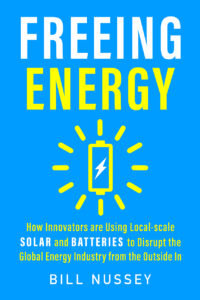
Thomas Edison famously told his good friends Henry Ford and Harvey Firestone,
“We are like tenant farmers chopping down the fence around our house for fuel, when we should be using Nature’s inexhaustible sources of energy—sun, wind, and tide. I hope we don’t have to wait until oil and coal run out before we tackle that.”
Edison’s quote is most remembered as an endorsement of clean energy. But he makes another point that doesn’t get as much attention – we WILL run out of fossil fuels. In fact, we will run out of natural gas, coal, and even uranium much sooner than most people realize. It may not be during many of our lifetimes, but it will most certainly be during our children’s.
We run out of coal in 150 years
There is a lot of coal buried in the ground. The problem is that most of it is too expensive to dig up or the quality is too low to use economically. So, exactly how much coal can be economically recovered in the US?
GET MONTHLY NEWS & ANALYSIS
Unsubscribe anytime. We will never sell your email or spam you.
A wide range of experts have looked hard at this. Their results are all over the map. The US Energy Information Administration (EIA) says we have 280 years worth of coal but their analysis is widely criticized. Even the coal industry disagrees with the EIA. The World Coal Association puts economically recoverable reserves at 150 years. Given the importance of coal reserves for energy policy and planning, the National Academy of Sciences, Engineering, and Medicine produced a 170 page book analyzing coal reserves for US policy makers. After reviewing all major coal reserve estimates, the National Academy predicts we have about 100 years of usable coal remaining. For simplicity, I’ll split the difference and go with the coal industry’s 150 year number.
Natural gas runs out in 50 years
In the case of natural gas, the International Gas Union’s 50-year projection is more widely accepted. But predictions still vary. British Petroleum predicts 52 years of natural gas remain. The Potential Gas Committee, a major industry group focused entirely on this question, predicted in 2018 that we would have well over 100 years of gas reserves, so as you can see we may be trending in the wrong direction.
Uranium-235 reserves are predicted to last 90 years
While not technically a fossil fuel, Uranium is also a finite form of fuel. Like coal and gas, it is buried in the ground in varying qualities and geographies. And like coal and gas, predictions for reserves are all over the map. A nuclear trade group, World Nuclear Association, puts reserves at 90 years.
But nuclear has a few more cards up its sleeve. Current reactors use Uranium 235 which is just 1% of overall Uranium deposits. Newer, but largely unproven types of reactors, can use the far more common U-238. And, if scientists can ever crack the code on nuclear fusion, which uses hydrogen isotopes found easily in the ocean, the amount of fuel is practically endless.
A note on predicting fuel reserves
Yogi Berra once said, “’It’s tough to make predictions, especially about the future.”
The literature on reserves is a jumble of concepts like reserves, resources, proven, economically viable, etc. All of these predictions are calculated based on numbers that are, themselves, impossible to predict. As examples:
- Rate of consumption – most analysis just uses recent consumption levels. If we use a lot less or a lot more of a fuel in future decades, then the predicted duration of reserves will go up or down accordingly.
- Market prices – if markets are willing to pay higher prices for a fuel then the amount of predicted reserves becomes much higher (there’s more money to pay for extracting and refining a fuel so companies can get at more of it).
- Technology – technology innovations can expand reserves by lowering the cost of extracting fuels. Hydraulic fracturing and horizontal drilling innovations massively raised the predicted natural gas and oil reserves in the early 21st century.
- New discoveries – intrepid companies and governments are regularly finding new places to dig up fuels. While most reserve estimates include a “best guess” for future discoveries, people have consistently been able to find more fuel than analysts predicted.
The point here is that fuel predictions that go out more than a few years are educated guesses at best. So how can policy makers decide on what to do? Here is my advice: don’t ignore the problem and force your grandchildren to solve it. If your car is driving towards a cliff somewhere off in the distance, the best strategy is to get out of the car long before you see exactly where the cliff is.
A different perspective on a hundred years
It’s easy to confuse a hundred years with forever. To make fossil fuel depletion more tangible, let’s shift the time frame. Let’s pretend that Edison, Ford, and Firestone’s generation was using fossil fuels at the rate we are today.
Edison was born in 1847. If the world was using fuels at today’s rates back then…
- Natural gas would have dried up in right in the middle of the Great Depression, 1933.
- Coal would have run out around the same time mobile phones became available, the late 1990’s.
- We’d be running out of nuclear fuel in the early 1980’s just around the time the world was realizing that disco music was really just a horrible phase best forgotten by history.
The Freeing Energy Perspective
The debate over fossil fuels, nuclear, and clean energy will likely continue for years.
It’s easy to forget that, in the end, fossil fuels simply won’t last more than a few generations. The most likely scenario is that over the next 100 years, clean energy from the sun, wind, and batteries will become so inexpensive that there is simply no reason to keep digging up more expensive fuels. But, if clean energy does suddenly stop its decades of cost improvements, we’ll need to find some other affordable way to create electricity.
Because… before we know it, there won’t be any cheap coal, gas, or uranium left.




